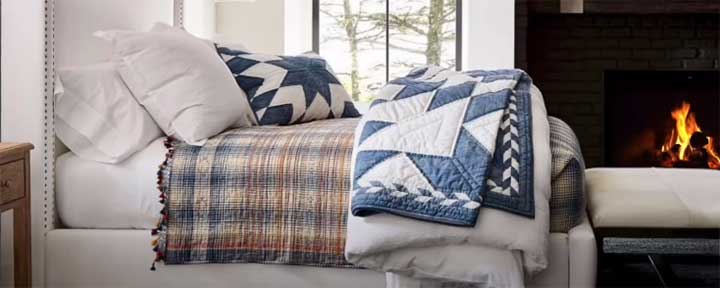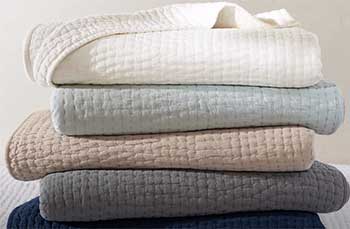When it comes to home furnishings, Pottery Barn is one of the most well-known and trusted brands. Known for its classic and timeless style, Pottery Barn offers a wide selection of bedding options to suit any decor.
But with the high price tags, many wonder if Pottery Barn bedding is actually worth the investment. Here is an in-depth look at the pros and cons of Pottery Barn bedding to help you decide if it’s the right choice for your bedroom.
Overview of Pottery Barn Bedding
Pottery Barn’s bedding collection includes sheets, duvet covers, quilts, pillowcases and shams. The materials used include cotton, linen, silk, cashmere and wool. Some signature fabrics found in Pottery Barn bedding include:

- Belgian Flax Linen – Made from Belgian flax, this linen is lightweight and breathable. It has a subtle sheen and relaxed wrinkled texture.
- Organic Cotton – Grown and woven in an audited, certified organic environment. The cotton is free of synthetic pesticides and fertilizers.
- Supima Cotton – Made using extra-long staple Supima cotton that is soft, smooth and durable.
- Cashmere – Pottery Barn uses Mongolian cashmere known for its softness and warmth.
- Alpaca Wool – This wool comes from Alpaca in South America and is durable, soft and breathable.
Pottery Barn’s bedding is designed to layer together, so you can mix and match sheets, duvets, toppers and shams to create a custom bed. They also have complete bedding sets available to simplify the process.
Pros of Pottery Barn Bedding
- High Quality Materials
The cotton, linen, cashmere and wool used in Pottery Barn bedding are all high grade, luxury materials. The Belgian flax linen and Supima cotton have extra-long fibers that create very soft and breathable fabrics.
The attention to material quality means the bedding will last for many years with proper care.
- Timeless and Classic Styles
Pottery Barn is known for classic designs that stand the test of time. The bedding avoids overly trendy looks, which helps it stay fashionable for longer.
The collections feature simple, refined patterns and textures in neutral palettes that can work in a variety of decors.
- Wide Range of Choices
With different fabric options like linen, cotton, cashmere and wool, along with weaves like percale, sateen and flannel, Pottery Barn offers a diverse lineup. You can find light and breezy warm weather bedding as well as cozy bedding for winter. The mix and match collections allow creating customized layers too.
- Ethical Production Standards
Pottery Barn aims to ensure its products are ethically produced. They partner with suppliers that uphold fair labor practices and safe working conditions. The cotton and wool used are certified by environmental organizations like OEKO-TEX.
- Quality Construction and Details
Details like double stitched seams, button closures on duvet covers, monogramming options and piping edges help the bedding withstand frequent use. The precise tailoring and construction prevent ripping, shrinking and other damage over time.
- Easy Care
Most Pottery Barn bedding can be conveniently machine washed and tumble dried for easy care and maintenance. Wrinkle-resistant finishes help the bedding look neat when properly handled. bedding life and appearance.
- Great for Gift Giving
With its classic styling and brand reputation, Pottery Barn bedding makes an excellent gift. The presentation is beautiful with packaging options like gift boxes and bags. Monogramming many pieces adds a personal touch.
Cons of Pottery Barn Bedding

- Expensive
The biggest downside of Pottery Barn bedding is the above average price point. The quality materials and construction come at a cost. With high thread counts and luxury fabrics like Belgian linen, the sheet sets can cost up to $500 or more.
- Limited Color/Pattern Choices
Those looking for bright colors, bold prints or trendy patterns may be disappointed with Pottery Barn’s subdued color palette and reliance on solids and simple stripes. The focus on versatile, trans-seasonal style means less variety.
- Wrinkling Issues
Some customers note frustration with wrinkling. Linen and cotton sheets are prone to wrinkles, which require either ironing or a period of readjustment on the bed. The care requirements may be more than some consumers expect.
- Shrinkage Problems
As with any natural fabric, shrinkage is possible if the bedding is improperly dried on high heat. Failure to follow care instructions can lead to fitted sheets no longer fitting the mattress.
- Few Budget-Friendly Options
There are very few bedding options under $100 at Pottery Barn. Those on a tight budget may find the prices prohibitive. However, the quality can justify the prices for many.
- Lack of Return Policy
Unfortunately Pottery Barn does not allow returns or exchanges on bedding. The only exception is if an item arrives defective or damaged. This can make purchasing bedding sight unseen risky.
Pottery Barn Bedding Material Pros and Cons
Beyond the overall pros and cons, we’ll take a deeper look at Pottery Barn’s main bedding materials:
Belgian Flax Linen

Pros
- Extremely soft and breathable
- Durable and gets softer over time
- Naturally antimicrobial and resistant to dust mites
- Ideal for hot sleepers
- Relaxed look with rumpled texture
Cons
- Wrinkles easily
- Lower thread count around 250
- Expensive
- Takes longer to dry
Supima Cotton
Pros
- Soft yet durable extra-long fiber cotton
- Gets softer with washing
- Breathable and moisture wicking
- Easy to maintain
Cons
- Not as soft as other high end cottons
- More expensive than regular cotton
- Still prone to some wrinkling
Organic Cotton
Pros
- Sustainably grown without chemicals
- Breathable and good temperature regulation
- Good for sensitive skin
- Durable natural fabric
Cons
- More expensive than regular cotton
- Wrinkling can still be an issue
- Lower thread counts around 300
Cashmere
Pros
- Extremely soft and luxurious warmth
- Lightweight and breathable
- Natural moisture wicking abilities
- Odor resistant
Cons
- Very expensive
- Delicate and requires gentler cleaning
- Shedding and pilling possible
- Warmer, so not ideal year round
Alpaca Wool
Pros
- Naturally soft, breathable and thermoregulating
- Durable yet lightweight
- Resists dust mites and mildew
- Responsibly sourced
Cons
- Expensive
- Wool can irritate sensitive skin
- Warmer for winter use
How Pottery Barn Bedding Compares To The Competition?
Pottery Barn established itself as a leader in the bedding space, but it faces competition from a number of other premium brands. Here’s an overview of how Pottery Barn compares:
Pottery Barn vs. Brooklinen
Brooklinen
- Specializes in linen bedding and towels
- Direct-to-consumer brand with lower prices
- Minimalist aesthetic with limited colors
- Focus on sustainability and ethical factories
Pottery Barn
- Wider selection beyond just linen
- Established luxury brand name and reputation
- More classic and traditional styles
- Higher prices but occasional sales/promos
Verdict: Brooklinen wins for lower prices on its high-quality linen, while Pottery Barn offers more variety in materials and classic styling.
Pottery Barn vs. Parachute
Parachute
- Focus on luxury bedding and bath linens
- Direct-to-consumer pricing with good value
- Cloud cotton and linen options
- Simple, minimalist styles
Pottery Barn
- Retail presence and brand recognition
- More bedding pieces like quilts and pillows
- Tailored details and piping for added polish
- Monogramming options available
Verdict: Parachute edges out with its lower direct pricing, while Pottery Barn has more selection.
Pottery Barn vs. Boll & Branch
Boll & Branch
- Leader in organic cotton bedding
- Emphasis on fair trade and sustainability
- Simple, classic color palette
- Direct-to-consumer pricing
Pottery Barn
- Broader range of fabric choices
- Established luxury name and styling
- Wider range of complementary accessories
- Occasional discounting on sales
Verdict: Boll & Branch wins on organic credentials and fair pricing, but Pottery Barn offers more variety.
Pottery Barn vs. Snowe
Snowe
- Focus on linen, cotton, and percale
- Direct-to-consumer pricing and model
- Trendy, contemporary styles
- Focus on technology and innovation
Pottery Barn
- Timeless and traditional aesthetics
- Retail sites for testing products
- Wider selection of bedding materials
- Monogram and personalization options
Verdict: Snowe delivers better pricing with its modern styles, while Pottery Barn has broader selection and classic look.
Pottery Barn vs. West Elm
West Elm
- Trend-driven modern designs
- Part of Williams-Sonoma brand family
- Lower and mid-tier pricing
- Constant new collections
Pottery Barn
- Timeless, refined styles
- Luxury level quality and materials
- Higher price points
- Classic brand name recognition
Verdict: West Elm is better for budget-conscious shoppers and contemporary style, while Pottery Barn offers elevated luxury and enduring classics.
Overall, Pottery Barn bedding holds it own against competitors with quality construction, luxury fabrics and tailored classic style. For those wanting variety in materials, monogramming and gift-giving, Pottery Barn remains a solid premium choice despite higher prices.
But the direct-to-consumer brands edge out in pricing while offering their own strengths like linen specialization or organic mission. At the end of the day, assessing your priorities will determine which brand is the best fit.
Pottery Barn Bedding FAQ
Pottery Barn’s Belgian Flax linen sheets provide an ultra soft, breathable and durable sleeping option. The quality European flax and tailored construction ensure the sheets get softer with time and last for years. So for those who love the relaxed wrinkled linen look and durability, Pottery Barn linen can be worth the higher prices.
The ‘best’ bedding depends on your sleep needs and preferences. Key factors include climate, temperature preference, season, health issues, and budget. Some top options are linen for breathability and warmth control, Percale cotton for easy care durability, sateen cotton for softness, and cashmere for luxurious warmth, though the price will be higher. Choosing sustainably sourced fabrics like organic cotton is also recommended.
Pottery Barn sources their Belgian Flax linen from Belgium. It is woven in one of the world’s finest linen mills located in Belgium using premium European flax. The special weaving process and European origins result in a distinctly soft, breathable and high end linen.
Belgian flax linen has a smooth, crisp texture that feels lightweight and breathable. It has a subtle sheen and a relaxed look, prone to wrinkles that give it casual elegance. Belgian linen gets even softer with washing, though it takes time to break in. Overall, it feels extremely soft yet durable – not as slinky as silk or as crisp as cotton. The special Belgian flax fibres enhance softness and durability.
The Bottom Line
When it comes to luxury bedding, Pottery Barn delivers quality materials, ethical production methods, classic tailored style and durable construction. For those seeking a timeless, refined look for their bedroom with soft, comfortable and long-lasting bedding, Pottery Barn is an excellent choice.
However, the high costs and limited color/pattern options may make it less accessible or ideal for some budgets and tastes. Paying close attention to fabric choice, care requirements and policies can ensure you make the most of Pottery Barn bedding.
Overall, for many shoppers, investing in Pottery Barn bedding can be well worth it when viewed as a long-term purchase for enhanced sleep comfort and style.
